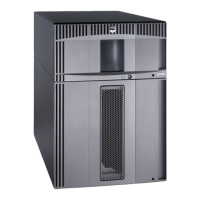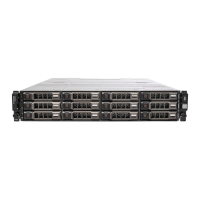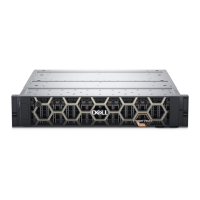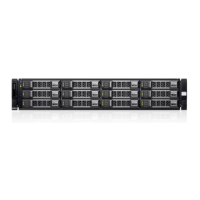136 Library Installation and CRU Replacement
8 Cable the library as described in Cabling Libraries with Fibre Channel Tape Drives Connected to Fibre
Channel I/O Blades on page 34.
9 Save the library configuration. See Saving and Restoring the Configuration
on page 12.
Removing an FC I/O Blade
These instructions explain how to remove an FC I/O blade from your library. You can remove an FC I/O
blade while the library is powered on.
Required tools: None
1 Remove the FC I/O blade from the system view. From the Web client, select Setup > Blade Control >
Remove. This removes the FC I/O blade from the system and powers it off.
2 Access the back of the expansion module containing the I/O blade.
3 Tag and disconnect all FC cables from the FC I/O blade.
4 Lift the latch hooks out of the locked position and push them up. You will feel the FC I/O blade unplug
from the expansion module’s backplane.
5 Continue lifting on the latch hooks until the blade is totally unplugged from the backplane.
6 Slide the FC I/O blade out of the expansion module.
7 Make sure that cover plates are installed over any unused bays in the expansion module.
8 If you are permanently removing the I/O blade, you will need to configure the library to stop monitoring
the I/O blade. See the library Users Guide for more information.
9 Save the library configuration. See Saving and Restoring the Configuration
on page 12.
Replacing an FC I/O Blade
These instructions explain how to replace an FC I/O blade in your library. You can remove and replace a
FC I/O blade while the library is powered on.
Required tools: None
1 Remove the FC I/O blade from the system view. From the Web client, select Setup > Blade Control >
Remove. This removes the FC I/O blade from the system and powers it off.
If you do not remove the FC I/O blade from the system view, the library will
generate a RAS ticket when you remove the I/O blade. If you do not want the
library to generate a RAS ticket, you can power down the I/O blade before
removing it. See the User’s Guide for more information. Refer to “Controlling
FC I/O Blade Power” in the ML6000 User’s Guide.
Handle the FC cables with care. They will be damaged if they are bent
at more than a four-inch arc.
If you do not remove the FC I/O blade from the system view, the library will
generate a RAS ticket when you remove the I/O blade. If you do not want the
library to generate a RAS ticket, you can power down the I/O blade before
removing it. See the User’s Guide for more information. Refer to the section on
Controlling FC I/O Blade Power in the ML6000 User’s Guide.

